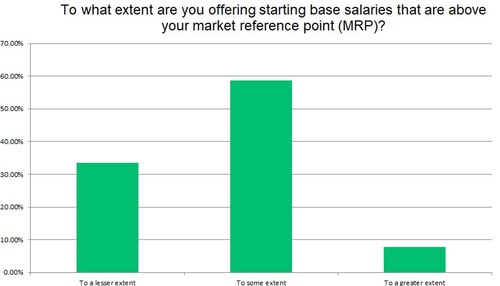The majority of US companies are increasing base salary in a bid to attract new staff in the current war for talent, according to Salary.com.
This is not bad news for new hires as more than 62% of organisations are planning to increase base salaries to attract new hourly and salaried employees within the next six months; which will increase their labour costs. Additionally, 67% said their starting base salaries are now above market rates.
However, job seekers hoping to secure signing bonuses had better move quickly, as employers are indicating that these bonuses are a short-term fix for widespread talent shortages. While 50% of employers are offering signing bonuses, only 20% expect to still be doing so at the end of 2021, the survey revealed.

SIGNING & RETENTION BONUSES
With 82% of employers saying they perceive a talent shortage, the prevalence of signing bonuses is not surprising. Signing bonuses have been deployed in relatively equal measure to both salaried and hourly workers; with hourly employees getting a median bonus of $1,000 and salaried employees getting a median bonus of $5,000. Retention bonuses have been leveraged by 21% of companies surveyed. Of those, 38% offer these bonuses to both salaried and hourly workers.
Median retention bonus rates and lengths of service:
| Hourly employees: $1,000 | Months: 6 |
| Salaried employees: $7,500 | Months: 12 |
NEW HIRE SALARY INCREASES
Both hourly and salaried new hires stand to benefit from salary increases, according to the survey. Around 65% of organisations are likely to increase base salary rates for hourly employees in the next six months. Additionally, 62% plan to do so for salaried workers.
“The prevalence of signing bonuses to attract workers in high demand and short supply has proven to be a short-term phenomenon, as organisations move to a post-pandemic reality,” said Garry Straker, Compensation Consultant at Salary.com. “The shift to salary increases for new hires will have greater long-term impact, so organisations will have to move with care to attract new hires; while retaining existing employees. Retention of current employees will require proactively monitoring and addressing salary compression. Incumbent employees who see new hires making as much, or more than themselves, may feel they are being treated unfairly; and be tempted to look elsewhere to attain a higher pay rate.”
FLEXIBILITY & WORK-LIFE BALANCE
According to Straker, as companies work to address internal and external labour market dynamics, there will be an increased focus on HR metrics; the benchmarking of market data; as well as gauging employee sentiment. This is particularly true in an environment where employee expectations have changed; and there is heightened awareness of pay equity issues, he noted. The challenges and risks are greater in states such as California and Connecticut, where pay transparency is required.
“It’s important to realise it’s not just about pay for today’s employees; many of whom have expressed a strong preference for flexible work arrangements, advancement opportunities, greater diversity and alignment of cultural values that can make an employer attractive,” added Straker.
Anther new survey has revealed that a staggering 66% of staff – particularly younger workers – are ready to switch jobs right now for more flexibility and a better work-life balance. Click here to read more.







































